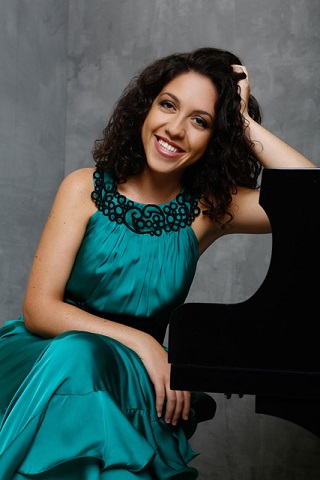 United States Stravinsky, Prokofiev, Rachmaninoff: Beatrice Rana (piano), The Philadelphia Orchestra / Yannick Nézet-Séguin (conductor), Carnegie Hall, New York, 7.6.2019. (RP)
United States Stravinsky, Prokofiev, Rachmaninoff: Beatrice Rana (piano), The Philadelphia Orchestra / Yannick Nézet-Séguin (conductor), Carnegie Hall, New York, 7.6.2019. (RP)

Stravinsky – Funeral Song Op.5
Prokofiev – Piano Concerto No.3 in C major Op.26
Rachmaninoff – Symphony No.1 in D minor Op.13
Euphoria reigned at Carnegie Hall when the final notes of Prokofiev’s Third Piano Concerto sounded. Conductor Yannick Nézet-Séguin beamed, and a surprising number of the usually stolid players of The Philadelphia Orchestra wore broad smiles. Front and center stood pianist Beatrice Rana, resplendent in yellow, her reaction more subdued but elated.
This was Rana’s second appearance in New York, although she has appeared at major European venues with leading conductors and orchestras for a number of years. Her debut recital at Carnegie Hall’s Zankel Hall this past March received rave reviews, and along with her recordings it had obviously whetted this audience’s appetite for more. The fiendishly difficult Prokofiev concerto is one of her calling cards. The composer himself noted its technical challenges, but Rana’s poise and masterful performance seemed to belie his assertion.
The brief clarinet introduction to the first movement was tender and beautiful. Throughout, the strings’ playing was luminous, with Nézet-Séguin giving the vast sweeps of melody space to arch skyward and bloom. That same lyricism prevailed in Rana’s playing, although the massive chords of the first movement were wondrous. The nonchalance with which she tossed off clusters of high notes was one of her few displays of showmanship. Even in the most aggressive passages, there was an intimacy in Rana’s approach to the music.
It was electrifying from the start. Without a moment’s hesitation or the slightest embarrassment over a breach of concert etiquette, there was an eruption of applause after the first movement that brought a smile to Rana’s face. During the third movement, a young man in the second row caught my eye. He was punching the air with his fist, as if willing the orchestra and soloist to play even louder and faster. As the final notes sounded, the audience sprang to its feet. She offered a single encore, Chopin’s Etude in A flat major, which found her at her most introspective and expressive.
Nézet-Séguin constructed a fascinating program that featured three composers whose careers were impacted by the Russian Revolution: Rachmaninoff, Stravinsky and Prokofiev all fled their homeland in its aftermath. Prokofiev, the youngest of the three, left with the approval of the Soviet authorities and would later return to live in the Soviet Union. Rachmaninoff went to the US where his career as a pianist curtailed his compositional efforts; he died in Beverly Hills in 1943. Stravinsky lived in Los Angeles for years and moved to New York City shortly before his death in 1971. Prokofiev enjoyed relative artistic freedom upon his return in 1938, until he was officially denounced by the government a decade later. He died in 1953 on the same day as Stalin.
During their lifetimes, Stravinsky’s Funeral Song and Rachmaninoff’s Symphony No.1 were thought to be lost. The former was a critical success for Stravinsky at its premiere in 1909, while Rachmaninoff’s symphony was deemed a disaster. The orchestral parts for both were found in the St. Petersburg State Conservatory’s library, the Rachmaninoff two years after his death in 1945 and the Stravinsky in 2015. Prokofiev’s concerto suffered no such fate. He recorded it with the London Symphony Orchestra in 1932, and it is one of his most popular works.
Stravinsky composed Funeral Song, laden with the spirit of Wagner, as a tribute to Rimsky-Korsakov, his teacher. It’s a postcard from that earlier time when student and teacher went to performances of the Ring cycle in St. Petersburg, before Stravinsky professed to loathe the German composer. Although solemn, it is a perfect curtain raiser as the instruments seem to go in procession by the tomb of the master, passing the same melody from one group to another. The tremolos throughout evoke the bass rumblings in Russian Orthodox Church music.
Rachmaninoff’s First Symphony is also a somber work: the melody of the Dies irae runs through all four movements. There are glimpses of the mature composer in the score, principally in his melodic invention, but they seem to end abruptly, just at the point when in later works they would take flight. It is an urgent score, notably the great fugal passages where the strings, especially the cellos and double basses, got the chance to really dig in and have some fun. Needless to say, they sounded magnificent.
The Larghetto, the third movement of the symphony, was the lightest and most charming music of the entire program. Nézet-Séguin conducted it with grace and simplicity, and the orchestra’s sound shimmered in the hall. The finale is flamboyant and loud, and chief among its thrills were the violas reveling in the fast and furious passages that Rachmaninoff composed for them. The symphony ends with ponderous brass fanfares, the beat of the tympani and the crash of the cymbals; hardly subtle, but Nézet-Séguin and the Philadelphians made it grand.
Rick Perdian